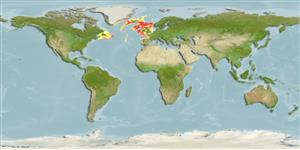Anthozoa |
Zoantharia |
Epizoanthidae
Environment: milieu / climate zone / depth range / distribution range
Ecology
Sessile; depth range 20 - 1500 m (Ref. 120359). Subtropical; 78°N - 37°N, 63°W - 3°E
Arctic, Atlantic Ocean and the Mediterranean. Subtropical to polar.
Length at first maturity / Size / Weight / Age
Maturity: Lm ? range ? - ? cm
Maximum depth from Ref. 120360. Known from circalittoral and bathyal zones (Ref. 85338). Pagurus bernhardus serves as its natural host (Ref. 119583). Found on sand and shell (Ref. 119584).
Life cycle and mating behavior
Maturity | Reproduction | Spawning | Eggs | Fecundity | Larvae
Members of the class Anthozoa are either gonochoric or hermaphroditic. Mature gametes are shed into the coelenteron and spawned through the mouth. Life cycle: The zygote develops into a planktonic planula larva. Metamorphosis begins with early morphogenesis of tentacles, septa and pharynx before larval settlement on the aboral end.
Cairns, S.D., D.R. Calder, A. Brinckmann-Voss, C.B. Castro, D.G. Fautin, P.R. Pugh, C.E. Mills, W.C. Jaap, M.N. Arai, S.H.D. Haddock and D.M. Opresko. 2003. (Ref. 1663)
IUCN Red List Status (Ref. 130435)
CITES status (Ref. 108899)
Not Evaluated
Not Evaluated
Threat to humans
Human uses
| FishSource |
Tools
More information
Age/Size
Growth
Length-weight
Length-length
Morphology
Larvae
Abundance
Internet sources
Estimates based on models
Preferred temperature
(Ref.
115969): 1.6 - 11.4, mean 7.8 (based on 400 cells).
Price category
Unknown.
